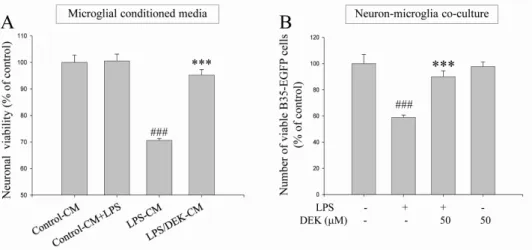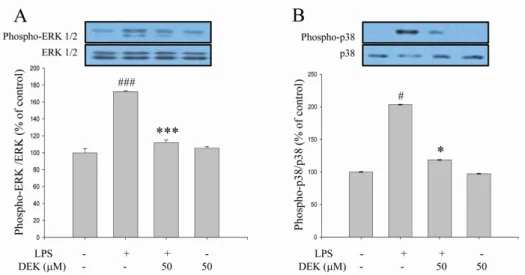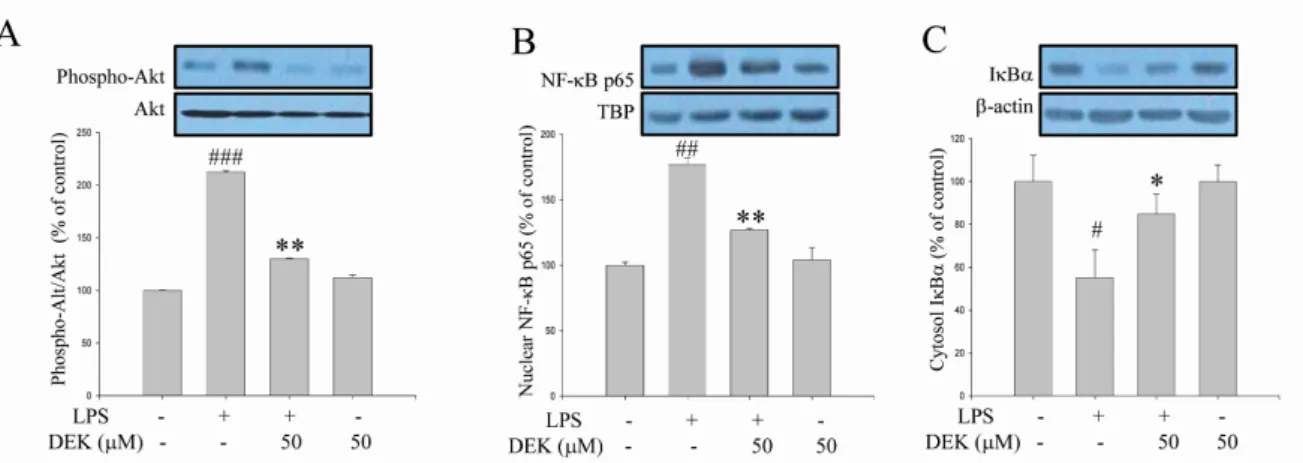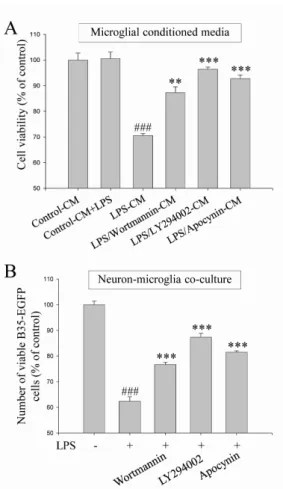219
http://dx.doi.org/10.4196/kjpp.2015.19.3.219 eISSN 2093-3827
ABBREVIATIONS: DEK, dieckol; DPI, diphenyleneiodium; ERK, ex- tracellular signal-regulated kinase; IκBα, inhibitor of κBα; LPS, lipopolysaccharide; NADPH oxidase, nicotinamide adenine dinuclelotide phosphate oxidase; NF-κB, nuclear factor κB; PI3K, phosphoinositide 3 kinase; ROS, reactive oxygen species; WT, Wortmannin.
Received November 10, 2014, Revised February 2, 2015, Accepted February 23, 2015
Corresponding to: Su-Yong Eun, Department of Physiology, Jeju National University School of Medicine, 102 Jejudaehakno, Jeju 690-756, Korea. (Tel) 82-64-754-3831, (Fax) 82-64-702-2687, (E-mail) syeun@jejunu.ac.kr
This is an Open Access article distributed under the terms of the Creative Commons Attribution Non-Commercial License (http://
creativecommons.org/licenses/by-nc/3.0) which permits unrestricted non-commercial use, distribution, and reproduction in any medium, provided the original work is properly cited.
Copyright ⓒ Korean J Physiol Pharmacol & MEDrang Inc.
Dieckol Attenuates Microglia-mediated Neuronal Cell Death via ERK, Akt and NADPH Oxidase-mediated Pathways
Yanji Cui
1, Jee-Yun Park
1, Jinji Wu
1, Ji Hyung Lee
1, Yoon-Sil Yang
1, Moon-Seok Kang
1, Sung-Cherl Jung
1, Joo Min Park
1, Eun-Sook Yoo
2, Seong-Ho Kim
3, Sangmee Ahn Jo
4, Kyoungho Suk
5, and Su-Yong Eun
1Departments of
1Physiology,
2Pharmacology, Jeju National University School of Medicine, Jeju 690-756,
3BotaMedi Inc. 307 Jeju Bio-industry Center, Jeju 690-121,
4Department of Nanobiomedical Science & BK21 PLUS NBM Global Research Center for Regenerative Medicine and Department of Pharmacology, Dankook University, Cheonan 330-951,
5Department of Pharmacology, Kyungpook National University School of Medicine, Daegu 700-842, Korea
Excessive microglial activation and subsequent neuroinflammation lead to synaptic loss and dysfunction as well as neuronal cell death, which are involved in the pathogenesis and progression of several neurodegenerative diseases. Thus, the regulation of microglial activation has been evaluated as effective therapeutic strategies. Although dieckol (DEK), one of the phlorotannins isolated from marine brown alga Ecklonia cava, has been previously reported to inhibit microglial activation, the molecular mechanism is still unclear. Therefore, we investigated here molecular mechanism of DEK via extracellular signal-regulated kinase (ERK), Akt and nicotinamide adenine dinuclelotide phosphate (NADPH) oxidase-- mediated pathways. In addition, the neuroprotective mechanism of DEK was investigated in microglia-- mediated neurotoxicity models such as neuron-microglia co-culture and microglial conditioned media system. Our results demonstrated that treatment of anti-oxidant DEK potently suppressed phosphorylation of ERK in lipopolysaccharide (LPS, 1 μ g/ml)-stimulated BV-2 microglia. In addition, DEK markedly attenuated Akt phosphorylation and increased expression of gp91
phox, which is the catalytic component of NADPH oxidase complex responsible for microglial reactive oxygen species (ROS) generation. Finally, DEK significantly attenuated neuronal cell death that is induced by treatment of microglial conditioned media containing neurotoxic secretary molecules. These neuroprotective effects of DEK were also confirmed in a neuron-microglia co-culture system using enhanced green fluorescent protein (EGFP)-- transfected B35 neuroblastoma cell line. Taken together, these results suggest that DEK suppresses excessive microglial activation and microglia-mediated neuronal cell death via downregulation of ERK, Akt and NADPH oxidase-mediated pathways.
Key Words: Akt, Dieckol, gp91
phox, Microglia, Neuron-microglia co-culture
INTRODUCTION
Microglial cells are the resident innate-immune cells in the brain, which play a physiological role of immune sur- veillance and host defense. However, it is generally ac- cepted that excessive microglial activation and subsequent neuroinflammation lead to synaptic loss and dysfunction as well as neuronal cell death. These changes are involved in
the pathogenesis and progression of several neurodegenerative diseases [1,2].
Microglia, in response to brain injury or immunological stimuli, produce excess nitric oxide (NO) and proinflammatory cytokines such as interleukin-1β (IL-1β), interleukin-6 (IL-6), and tumor necrosis factor-α (TNF-α), which are consid- ered to contribute to neuronal cell death and neurodegenerative processes. Multiple signaling pathways are involved in the expression of these molecules. Protein kinases such as mi- togen-activated protein kinases (MAPKs), protein kinase C (PKC) and phosphoinositide 3 kinase (PI3K)/Akt are involved, while nuclear factor κB (NF-κB) are recruited in micro- glial activation pathways [3,4].
In addition, the role of nicotinamide adenine dinuclelo-
tide phosphate (NADPH) oxidase has been emphasized in
the microglial activation process. The NADPH oxidase, as the major source of microglial reactive oxygen species (ROS), is an enzyme complex composed of various membrane and cytosol subunits depending on cell types. Nox1, Nox2 and Nox4 isotypes are expressed as the catalytic subunits of NADPH oxidase in microglia [5,6]. Nox2 (also known as gp91
phox) is the most responsive in activated microglia [6].
Nox2-dependent NADPH oxidase consists of two membrane- bound subunits and four cytosolic subunits in microglia.
Upon phosphorylation by specific kinases, the cytosolic sub- units form a complex and translocate to the membrane to dock with the membrane subunits and activate NADPH ox- idase complex. Then, the activated NADPH oxidase generates the superoxide anion (·O
2-) by reducing O
2, that can be con- verted to other ROS molecules [7,8]. A growing body of evi- dence has indicated that NADPH oxidase and NADPH oxi- dase-derived ROS are associated with MAPKs, Akt and NF- κB, and thereby play an important role in microglial acti- vation and neuroinflammation [3,9-11].
Many compounds derived from plants have been widely investigated as candidates for medicinal application. It has been previously reported that dieckol (DEK) isolated from marine brown alga Ecklonia cava (EC) exhibits anti-in- flammatory and antitumor activity as well as free radical scavenging activity [12,13]. In the central nervous system, DEK was shown to inhibit cyclooxygenase-2 (COX-2) and inducible nitric oxide synthase (iNOS) in activated micro- glia following LPS stimulation [14]. However, the molecular mechanism underlying neuroprotective activity of DEK still remains to be elucidated.
Therefore, we further investigated here whether DEK in- hibits microglial activation via ERK, Akt, and NADPH oxi- dase-mediated pathways in activated microglia. In addi- tion, we found, using a neuron-microglia co-culture system and microglial conditioned media system, that DEK in- hibits neuronal cell death following excess activation of ad- jacent microglial cells.
METHODS Reagents
Dulbecco’s Modified Eagle Medium (DMEM), fetal bovine serum (FBS), penicillin/streptomycin and Alexa Fluor 488-con- jugated goat anti-rabbit antibodies were obtained from Invitrogen (Carlsbad, CA, USA). LY294002, Wortmannin and diphenyleneiodium (DPI) were purchased from Calbiochem (La Jolla, CA, USA). Antibodies against extracellular sig- nal-regulated kinase (ERK), phospho-ERK, Akt, phospho-Akt, nuclear factor κB p65 (NF-κB p65) and inhibitor of κBα (IκBα) were purchased from Santa Cruz Biotechnology (Santa Cruz, CA, USA). Antibodies against p38, phospho-p38 and inducible nitric oxide synthase (iNOS) were purchased from Cell Signaling Technology (Danvers, MA, USA). Antibody against TATA binding protein (TBP) was purchased from Abcam (Cambridge, UK). Antibody against gp91
phoxwas pur- chased from BD biosciences (San Jose, CA, USA). Horseradish peroxide (HRP)-conjugated immunoglobulin G (IgG) anti- body was purchased from Vector Laboratories (Burlingame, MA, USA). All the other reagents were purchased from Sigma (St. Louis, MO, USA), unless indicated.
Extraction and isolation of DEK
DEK was kindly supplied by BotaMedi, Inc. (Seoul, Republic of Korea). Briefly, the whole plant of marine brown alga Ecklonia cava was collected from the Jeju Island coast in the Republic of Korea. The dried Ecklonia cava powder was extracted three times with 70% aqueous ethanol (EtOH) and then filtered. The filtrate was evaporated at 50
oC to isolate the ethanol extract. After the EtOH extract had been suspended in distilled water, it was partitioned two times with n-butanol. The n-butanol fraction was evapo- rated in a vacuum, and was subjected to ODS column chro- matography. The DEK compound was finally purified by LH-20 column chromatography and the purified DEK was then confirmed by comparing their mass spectrometry,
1




